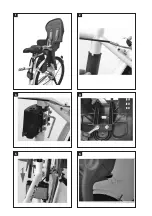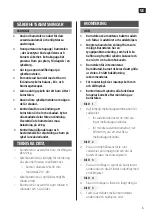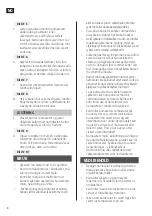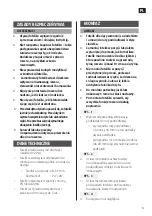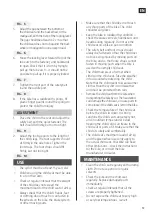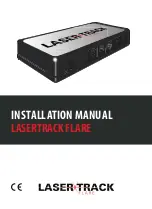
EN
13
• Make sure that the child does not touch
any sharp parts of the bike. The child
should wear gloves.
• Keep the bike in roadworthy condition –
check the brakes, wheels, handlebars and
head bearing regularly. Do not use the
child seat on a bike in poor condition.
• The safety belt and foot straps should
always be fastened so that the child does
not risk being injured by moving parts on
the bike, and so that loose straps cannot
fasten in moving parts when the bike is
used with an empty child seat.
• The child must wear a helmet when
sitting in the child seat. Take the weather
into account when dressing the child.
Note that the child needs to wear warmer
clothes than the cyclist in cold weather
and must be protected from rain.
• Remove the child seat from the bike when
transporting the bike by car. The head wind
can damage the child seat, or cause parts to
come loose if the child seat is left on the bike.
• Check the temperature of the child seat
before the child sits down. In strong
sunshine the child seat can get very hot,
and in outdoor temperatures below
freezing the child’s skin can freeze to the
child seat or parts of it. Make sure that the
child sits safely and comfortably.
• The child seat’s maximum load of 22 kg
and the given wheel sizes only apply to
the actual child seat. Your bike can have
other limitations – check the instructions
for the bike, or consult the bike
manufacturer or dealer.
MAINTENANCE
• Clean the child seat regularly with a damp
cloth. Do not use petrol or organic
solvents.
• Check the bike and the child seat
regularly. Replace damaged parts
immediately.
• Check at regular intervals that all the
screws are properly tightened.
• Do not expose the child seat to very high
or very low temperatures, rain etc.
FIG. 5
5. Adjust the gap between the bottom of
the child seat and the back wheel, or the
mudguard, with the help of the locking lever.
The gap should be at least 4–7 cm so that
the child seat does not rub against the back
wheel or mudguard on an uneven road.
FIG. 6
6. Move the locking lever forward to lock the
tube arch to the fastener, and backwards
to open.Check that it is firm by trying to
pull up the tube arch – it should not be
possible to pull up if it is properly locked.
FIG. 7
7. Tighten the front part of the safety belt
round the saddle post.
FIG. 8
8. If the bike has a saddle with springs, fit
plastic finger guards round the springs to
protect the child from injury.
ADJUSTMENT
1. Place the child in the seat and adjust the
safety belt with the quick fastener. The
belt should fit firmly, but not too tight.
FIG. 9
2. Adjust the foot supports to the length of
the child’s legs. The foot supports should
sit firmly in the side holes. Tighten the
foot straps. The foot straps should fit
firmly, but not too tight.
FIG. 10
USE
• The cyclist must be at least 15 years old.
• Children using the child seat must be able
to sit on their own.
• Check at regular intervals that the weight
of the child does not exceed the
maximum load for the child seat of 22 kg.
• Always check that the child’s hands, feet
or clothing do not touch or can fasten in
the wheels on the bike, the brake system
or other moving parts.
Содержание 001-172
Страница 3: ...1 2 3 5 6 4...
Страница 4: ...7 8 9 10...



